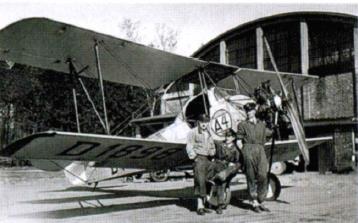A biplane single engine (Siemens Sh 14) touring plane with N-style connection between the wings and Handley-Page slats on the upper wing. Seating was side-by-side in this closed cabin. This was the last Raab-Katzenstein machine built in 1931 in one example.
| Type |
2/3 seat touring aircraft |
| Engine |
1 Siemens Sh 14 |
| Dimensions |
Length 7,10 m, height , span 9,60 m, wing area 22,0 m2 |
| Weights |
Empty 430 kg, loaded 750 kg , max. take off weight |
| Performance |
Max.. speed 190 km/h , cruising speed , range 700 km, endurance , service ceiling 4000 m , climb |
| Type |
Werk.Nr |
Registration |
History |
|
112 |
D-1898, A 4 |
Built 1931. Did not take part in the Europa-Rundflug 1932, even if it got number A 4 |
|
113 |
D-1899 |
Probably not finished (Ries) |
RK 29 feeder aircraft
There are no documents about this bird from 1930.
It was a 2- to 3-seater biplane with a cabin attached and a 100 hp Siemens Sh 14 engine. It was a STOL aircraft. In 1931 it was acquired by Raab-Katzenstein, but was no longer registered due to bankruptcy. Raab writes that this aircraft had flight characteristics similar to those of the stork.
The Raab-Katzenstein RK 29 Deutsche Motte was the first development of the Rheinische Luftfahrt-Industrie GmbH in Krefeld and the last development in the series of Raab-Katzenstein aircraft. It was built in 1930 as a competition aircraft for participation in the 1930 European round trip. In accordance with the competition specifications, Erich Gammelin and designer Schüttkowski designed it as a cabin aircraft with short takeoff characteristics. Since large parts of the design were taken from a DH60 Moth, the aircraft was given the type name "Deutsche Motte".
The city of Krefeld provided a loan of 10,000 RM for the construction of two competition aircraft. The two aircraft were completed in the early summer of 1930 and were probably flown into Krefeld. They were registered to take part in the European round trip with starting number A4 for Raab and D9 for Kurt Katzenstein. Due to the economic situation of Rheinische Luftfahrt-Industrie GmbH, the company no longer had the liquid funds to finance the sightseeing flight in July 1930. To finance this, Antonius Raab advertised the two aircraft in July 1930 to take part in the European sightseeing flight, but to no avail[2]. Participation in the European sightseeing flight was withdrawn in July 1930.
The two RaKa RK 29s were the last two aircraft to be completed in the summer of 1930 at the Raab-Katzenstein works and the Rheinische Luftfahrt-Industrie GmbH.
As is usual with RaKa designs, the design was a mixed construction with a welded steel tube fuselage and wings made of a fabric-covered wooden structure. The fuselage was not a new design, but was taken from a De Havilland DH60 Moth (possibly one of the unfinished RaKa RK 12s) and widened in the cockpit area so that three people could be accommodated in it. As a cabin aircraft, the cockpit area was covered with a canopy. The wing was largely redesigned and was relatively large at 22 m² in order to meet the short take-off characteristics required for the competition. The RK 29 was powered by a 110 hp Siemens Sh14 engine.

